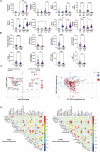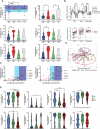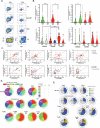Vaccine responses and hybrid immunity in people living with HIV after SARS-CoV-2 breakthrough infections
- PMID: 39384763
- PMCID: PMC11464709
- DOI: 10.1038/s41541-024-00972-3
Vaccine responses and hybrid immunity in people living with HIV after SARS-CoV-2 breakthrough infections
Abstract
The COVID-19 pandemic posed a challenge for people living with HIV (PLWH), particularly immune non-responders (INR) with compromised CD4 T-cell reconstitution following antiretroviral therapy (CD4 count <350 cells per mm3). Their diminished vaccine responses raised concerns about their vulnerability to SARS-CoV-2 breakthrough infections (BTI). Our in-depth study here revealed chronic inflammation in PLWH and a limited anti-Spike IgG response after vaccination in INR. Nevertheless, the imprinting of Spike-specific B cells by vaccination significantly enhanced the humoral responses after BTI. Notably, the magnitude of cellular CD4 response in all PLWH was comparable to that in healthy donors (HD). However, the polyfunctionality and phenotype of Spike-specific CD8 T cells in INR differed from controls. The findings highlight the need for additional boosters with variant vaccines, and for monitoring ART adherence and the durability of both humoral and cellular anti-SARS-CoV-2 immunity in INR.
© 2024. The Author(s).
Conflict of interest statement
The authors declare no competing interests.
Figures





References
LinkOut - more resources
Full Text Sources
Research Materials
Miscellaneous

